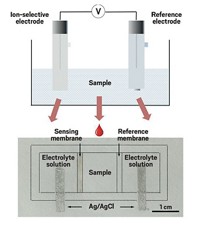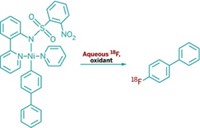Advertisement
Grab your lab coat. Let's get started
Welcome!
Welcome!
Create an account below to get 6 C&EN articles per month, receive newsletters and more - all free.
It seems this is your first time logging in online. Please enter the following information to continue.
As an ACS member you automatically get access to this site. All we need is few more details to create your reading experience.
Not you? Sign in with a different account.
Not you? Sign in with a different account.
ERROR 1
ERROR 1
ERROR 2
ERROR 2
ERROR 2
ERROR 2
ERROR 2
Password and Confirm password must match.
If you have an ACS member number, please enter it here so we can link this account to your membership. (optional)
ERROR 2
ACS values your privacy. By submitting your information, you are gaining access to C&EN and subscribing to our weekly newsletter. We use the information you provide to make your reading experience better, and we will never sell your data to third party members.
Synthesis
Pet Project
Microfluidic device synthesizes medical imaging probe in multistep process
by Celia Henry Arnaud
December 19, 2005
| A version of this story appeared in
Volume 83, Issue 51

TECHNOLOGY
In a demonstration of apotential medical niche for microfluidic reactors, a high-yielding multistep synthesis producing high-quality product has been carried out in a new microfluidic device about the size of a penny.
Multistep processes in microfluidic devices are often plagued by cross-contamination, side reactions, and poor yields. The device described by Stephen R. Quake of Stanford University; Hsian-Rong Tseng of the University of California, Los Angeles; and coworkers avoids these problems through the use of integrated pressure-driven microvalves.
Using the device, the team synthesizes 2-[18F]fluoro-2-deoxy-D-glucose ([18F]FDG), the most common probe used in PET imaging, at high radiochemical yield and purity and in shorter times than is possible with conventional synthesis (Science 2005, 310, 1793).
PET, or positron emission tomography, is a technique whereby radiolabeled probes are used to map biological processes. It is most commonly applied to diagnosing cancer. Because PET imaging requires doses of only about 180 ng, a full dose can be synthesized on the chip.
"Microfluidic devices are realistically going to make only nanograms of material," Quake says. "There are some cases where that's really useful, and PET imaging is one of them."
Currently, PET probes are synthesized at radiopharmacies and delivered to medical centers, Tseng says. "With this technology, we believe we are going to enable each medical center to do the imaging-probe synthesis on-site," he says.
The production of [18F]FDG requires five sequential chemical processes: the concentration of the radioactive fluoride, solvent exchange from water to acetonitrile, fluorination of the probe precursor, solvent exchange back to water, and acid hydrolysis of the fluorinated intermediate.
With the microfluidic reactor, the team can use higher concentrations of the radioactive isotope and speed up the reaction relative to the conventional synthesis. One of the new portions of the chip is an ion-exchange column that concentrates the radioisotope.
Some of the processes require elevated temperatures that are a challenge with the device, which is made of poly(dimethylsiloxane). In addition, PDMS is incompatible with many organic solvents. "There are definitely issues that need to be worked out before the device is commercialized," Quake says. Fluidigm, a microfluidics company in South San Francisco, and the molecular imaging division of Siemens Medical Solutions, Culver City, Calif., plan to commercialize the technology.
Quake and Tseng want to extend the range of chemical processes that can be carried out with the microfluidic devices. The team is working with Joseph M. DeSimone at the University of North Carolina, Chapel Hill, and Robert H. Grubbs at California Institute of Technology to develop materials compatible with a broader range of organic solvents.




Join the conversation
Contact the reporter
Submit a Letter to the Editor for publication
Engage with us on Twitter